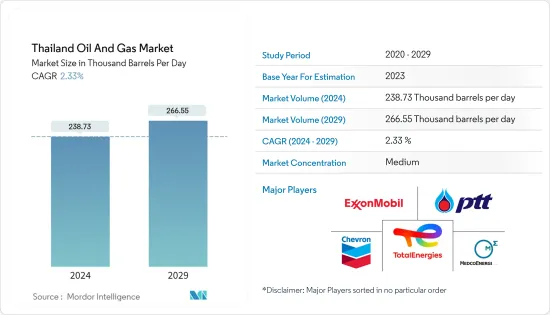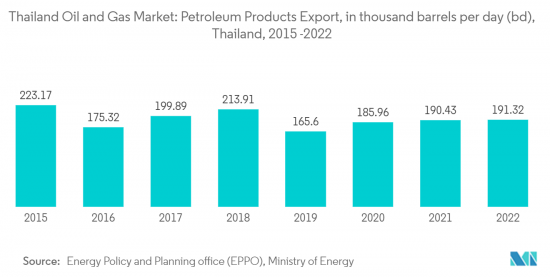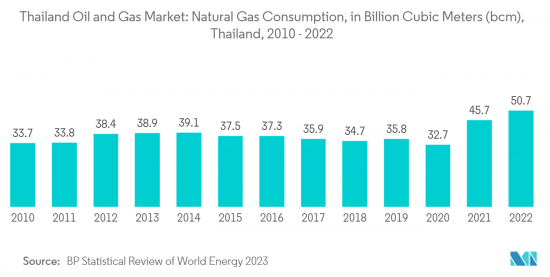Need help finding what you are looking for?
Contact Us
PUBLISHER: Mordor Intelligence | PRODUCT CODE: 1429251

PUBLISHER: Mordor Intelligence | PRODUCT CODE: 1429251
Thailand Oil And Gas - Market Share Analysis, Industry Trends & Statistics, Growth Forecasts (2024 - 2029)
PUBLISHED:
PAGES: 95 Pages
DELIVERY TIME: 2-3 business days
SELECT AN OPTION
The Thailand Oil And Gas Market size is estimated at 238.73 Thousand barrels per day in 2024, and is expected to reach 266.55 Thousand barrels per day by 2029, growing at a CAGR of 2.33% during the forecast period (2024-2029).

Key Highlights
- Over the medium term, factors such as the increasing natural gas pipeline capacity and the demand for petroleum products are expected to drive the Thailand oil and gas market during the forecast period.
- On the other hand, the country's new plans to transition towards renewable energy sources might hinder the Thailand oil and gas market.
- Nevertheless, discovering new oil and gas fields is expected to create several opportunities for the Thailand oil and gas market during the forecast period.
Thailand Oil and Gas Market Trends
Downstream Segment Expected to Witness Significant Growth
- The downstream sector corresponds to the final processes before the crude oil or gas can be dispensed to the final end customers or retail market. Major refineries for crude oil and natural gas processing plants are set up for the same; the process thus generates other major side products like gasoline, liquified natural gas, diesel, and other lubricants.
- In 2022, the export volume of petroleum products from Thailand amounted to almost 191.3 thousand barrels per day, a slight increase compared to the previous year. In the same year, Thailand exported diesel fuel the most compared to other petroleum products.
- The downstream refining sector of Thailand in the Southeast Asia region (in refining capacity and throughput) is one of the largest based on market cap, just after Singapore. The refinery throughput has grown in recent years due to rising domestic petroleum demand, rising petroleum prices, healthy growth in the tourism sector, and stable and high refinery margins.
- On the other hand, the refinery throughput has been increasing in recent years. The country currently has six refinery complexes, most of which are owned partially or fully by the country's national oil and gas conglomerate PTT. The country has been increasing its refining capacity to meet its growing domestic and regional demand.
- Thai Oil, the flagship refining company from Thailand, had already decided to expand its existing crude refining facility in Sriracha Oil Refinery in Laem Chabang by fueling approximately 4.8 billion dollars.
- In addition, the expansion will also see the addition of a residue hydrocracker, a vacuum gas oil hydrocracker, a hydrogen manufacturing unit, a diesel hydrodesulfurization unit, a naphtha hydrotreater, a sulfur recovery unit, and an electric power plant fueled by residue pitch.
- In August 2021, Hyundai Engineering received a USD 256 million EPC (engineering, procurement, and construction) order from IRPC PCL to upgrade its refinery with a total capacity of 215,000 barrels per day in Rayong, about 170 km southeast of Bangkok. According to Hyundai, the facility is expected to complete in early 2024 in line with the IRPC's plan.
- Thus, with all the above mentioned, Thailand's oil refining capacity is expected to grow slightly during the forecast period due to the expansion of refineries and increased demand for refined oil.

Energy Transition from Coal to Natural Gas Expected to Drive the Market
- To cope with the international clean fuel energy requirements and reduce its carbon footprints towards net zero, Thailand has already announced its transition from a coal-based economy to a gas-based economy.
- Well aware of its depleting natural gas reserves,, Thailand has already started to venture into Liquified Natural Gas (LNG) by developing its infrastructural requirements in its various seaports. The recently completed LNG terminal in Nong Fab, with a capacity of 7.5 million mt/year, has been the nation's example as it shifts towards natural gas.
- In 2022, natural gas consumption in Thailand amounted to around 50.7 billion cubic meters, slightly inclined compared to the previous year. Natural gas consumption in Thailand witnessed an increase of 10 percent in 2022.
- The country has a few under-construction and planned natural gas power plants, such as the Gulf Sriracha power plant (2.5 GW), Hin Kong Power Project (1.4 GW), Chonburi Ng Project power station (2.6 GW), and two other power plants in Surat Thani with 700 MW each. Commissioning of these power plants is expected to increase natural gas demand in Thailand.
- In February 2021, Thailand's state-controlled oil firm, PTT, announced that it s planned an investment of USD 28.3 billion across all its operations for 2021-2025. It focuses on developing the country's LNG and natural gas industry while seeking future energy opportunities.
- Therefore, owing to the above points, the increasing energy transition in the country is expected to drive the oil and gas market during the forecast period.

Thailand Oil and Gas Industry Overview
The Thailand oil and gas market is semi consolidated. Some of the major players in the market (in no particular order) are PTT Public Company Limited, Chevron Corporation, Exxon Mobil Corporation, TotalEnergies SE, and MedcoEnergi.
Additional Benefits:
- The market estimate (ME) sheet in Excel format
- 3 months of analyst support
Product Code: 47226
TABLE OF CONTENTS
1 INTRODUCTION
- 1.1 Scope of the Study
- 1.2 Market Definition
- 1.3 Study Assumptions
2 EXECUTIVE SUMMARY
3 RESEARCH METHODOLOGY
4 MARKET OVERVIEW
- 4.1 Introduction
- 4.2 Crude Oil Production Forecast, till 2028
- 4.3 Natural Gas Production Forecast, till 2028
- 4.4 Refinery Installed Capacity and Forecast, till 2028
- 4.5 Recent Trends and Developments
- 4.6 Government Policies and Regulations
- 4.7 Market Dynamics
- 4.7.1 Drivers
- 4.7.1.1 Expanding the Asia's Largest Downstream Sector
- 4.7.1.2 Energy Transition from Coal to Natural Gas
- 4.7.2 Restraints
- 4.7.2.1 Government Policies to Shift Towards Cleaner Fuels
- 4.7.1 Drivers
- 4.8 Supply Chain Analysis
- 4.9 PESTLE Analysis
5 MARKET SEGMENTATION - BY SECTOR
- 5.1 Upstream
- 5.2 Midstream
- 5.3 Downstream
6 COMPETITIVE LANDSCAPE
- 6.1 Mergers and Acquisitions, Joint Ventures, Collaborations, and Agreements
- 6.2 Strategies Adopted by Leading Players
- 6.3 Company Profiles
- 6.3.1 PTT Public Company Limited
- 6.3.2 Chevron Corporation
- 6.3.3 MedcoEnergi
- 6.3.4 Bangchak Corporation PCL
- 6.3.5 Pan Orient Energy (Siam) Ltd.
- 6.3.6 Sea Oil Energy Limited
- 6.3.7 Royal Dutch Shell PLC
- 6.3.8 Mitsui Oil Exploration Co. Ltd.
- 6.3.9 TotalEnergies SE
- 6.3.10 Exxon Mobil Corporation
7 MARKET OPPORTUNITIES AND FUTURE TRENDS
8 Discovery of New Oil and Gas Fields
Have a question?


SELECT AN OPTION
Have a question?


Questions? Please give us a call or visit the contact form.
